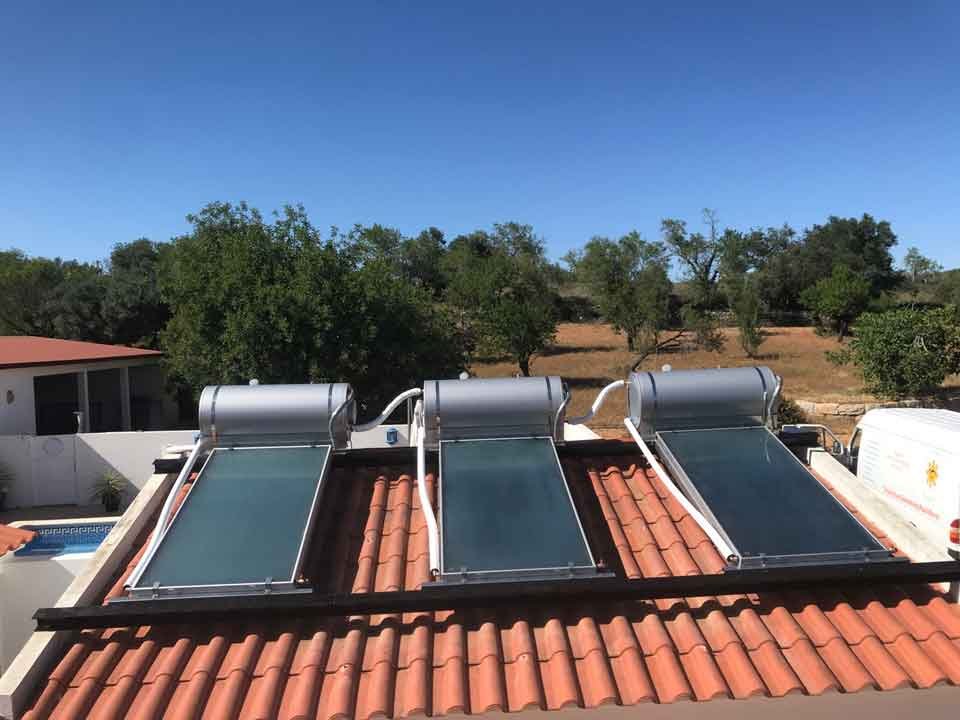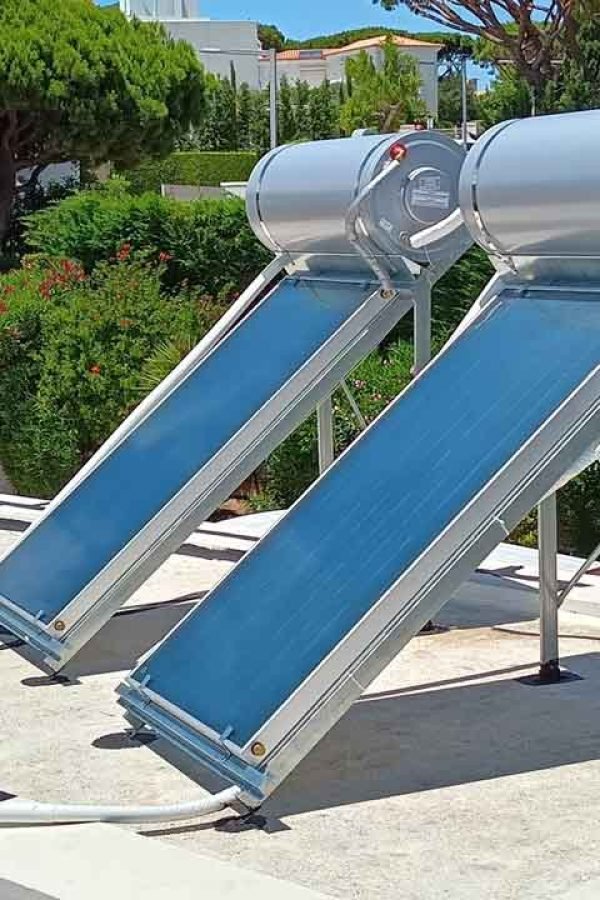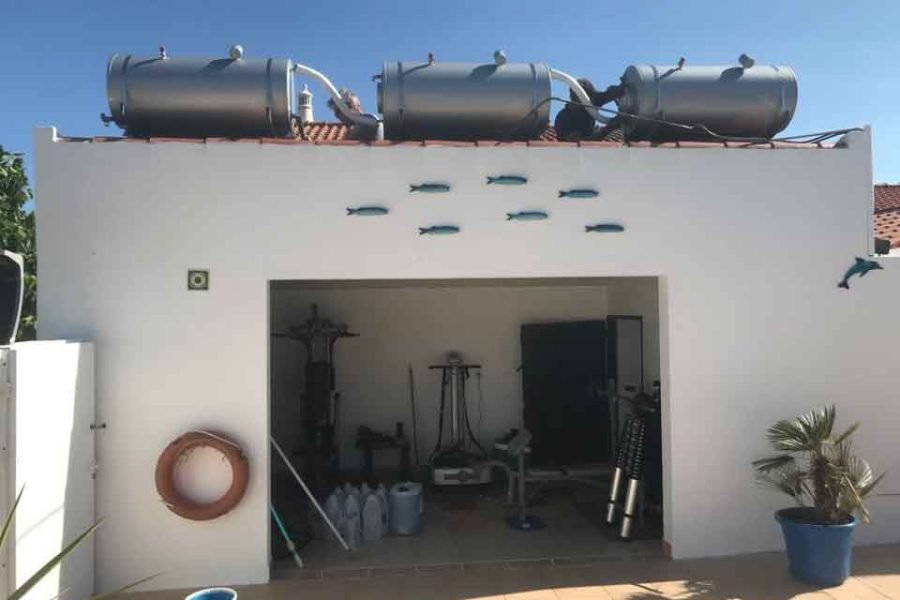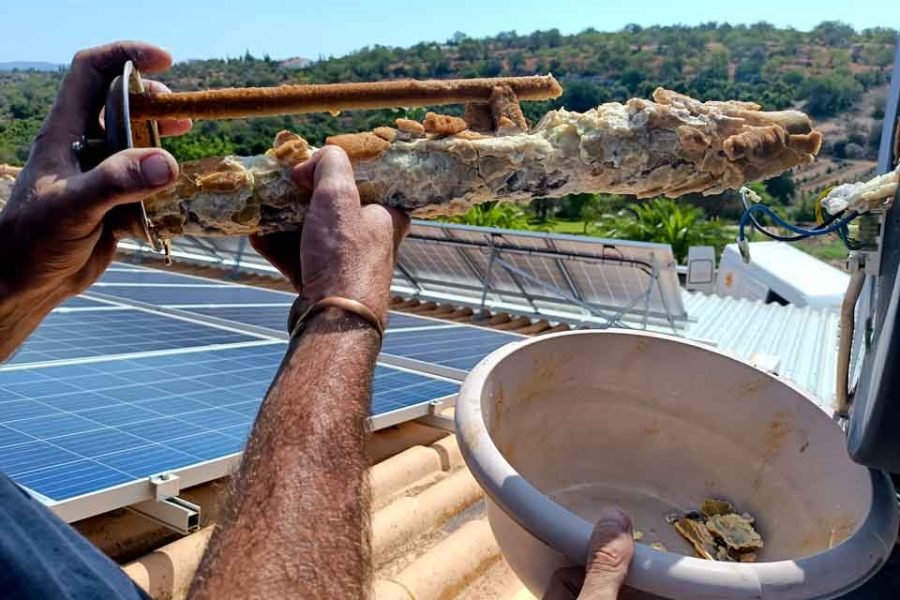

Thermosiphon Hot Solar Water Systems are the most straightforward, efficient and cost-effective way to use the sun’s energy to heat water for your household or business premises.
A key advantage of Thermosiphon Hot Solar Water systems is simplicity.
Relying on natural convection (heat rising), there is no need for any mechanical pumps or electricity, and no moving parts.
Making them reliable, cost-effective and requiring minimal maintenance.



Installed flush with the ground
Installed on frames
Installed on supporting beams on a roof
Modular Configuration / Feed-in Systems
Thermosiphon Hot Solar Water systems are modular and can be connected in series or parallel.
The advantage of a series connection is only the first storage tank is fed with cold mains supply water.
Each tank feeds the next tank in series with solar heated water, as opposed to mixing cold mains water with the solar heated hot water in the primary tank.
Only the last tank in series requires an electrical immersion heating element to top-up, maintain and guarantee the point of use water temperature, which need only be switched on when necessary / in the event of overcast weather.
An added advantage is the electrical element would only need to top up and maintain temperature in a smaller volume of water, rather than in the entire amount of stored water, and the solar energy would have already done the hard work.
This makes this configuration very efficient when it comes to electrical energy use.
Thermosiphon Hot Solar Water systems can be installed up-line of existing hot water storage tanks so as to feed solar heated water instead of cold mains water into existing infrastructure, whilst also increasing overall hot water storage capacity.
Hot Solar Water Installations



Hot Solar Water systems don’t always need to be installed on a roof!
This 150 litre Hot Solar Water Thermosiphon system was installed so as to blend in to the slope of the ground on the south facing side of the property.
A feed in system, this Hot Solar Water solution provides solar heated water into the existing household immersion water tank.
Not only does this double the hot water storage capacity, but instead of cold water being fed into the existing tank, it receives hot water heated by the sun…
This significantly reduces the reliance on electricity to heat the household water… and guarantees hot water at point of use, no matter the weather.



Two x 150 litre Hot Solar Water Thermosiphon Systems installed in series (one feeding into the other).
The new vertical storage tank below is fed with solar heated water, as opposed to cold mains supply water.
Only the indoor vertical storage tank requires an electrical immersion heater element, which is only there to top-up and maintain the water temperature when necessary.
With this solution the reliance on electricity to heat water is reduced significantly, and precise water temperature guaranteed.



Three x 150 litre Hot Solar Water Thermosiphon systems installed in series – each feeding solar heated water into the next.
Only the last tank in the series requires a back-up electrical element to top up, maintain and guarantee the point of use water temperature during overcast weather.
A super efficient configuration
Servicing & Maintenance



Hot Solar Water systems (and hot water tanks in general) need servicing and maintaining ideally once a year, at minimum every 18 – 24 months.
Regular servicing and preventative maintenance will result in more efficiency, extended lifespan, cost savings and peace of mind.
After a very hot summer there is a good chance some of the glycol will have escaped and will need topping up.
Due to high mineral content of water, calcification occurs in tanks and on elements and needs removing regularly.
Dirty solar panels also reduces the amount of thermal energy that gets transferred – regular cleaning is recommended.
Calcification
When water is heated it can cause minerals present in the water to turn from a dissolved state into solid particles. These particles accumulate on the inner surfaces of the water tank, heating elements and plumbing components.
This can lead to several issues, including reduced heating efficiency, longer heating times, damage to heating elements and pipe blockages.
It can also reduce the amount of hot water available and increase energy costs because the heating system has to work harder to heat the water.
Electrolysis
When water and different types of metal meet, electrolysis occurs.
Add to this the fact that dissolved minerals in water act as a conductor of electricity and you have an exchange of electrons, which causes metals to corrode and break down over time.
Anode
The anode, also known as a sacrificial rod, is made of a metal that is more “attractive” to corrosion than the metal used in the tank. In essence, the anode “sacrifices” itself to protect the tank.
Over time, as the anode corrodes, it becomes less effective at protecting your water tank.
Glycol (heat transfer fluid)
Over time glycol degrades due to exposure to high temperatures.
This degradation can reduce its heat transfer efficiency, breakdown its corrosion inhibitors and lower its ability to prevent freezing.
In hot weather the glycol also helps prevent overheating of the solar collector panel. If the glycol isn’t filled properly or functioning correctly, it can’t dissipate heat effectively, potentially causing damage to the system and reducing its efficiency.
Dirty Solar Panels
When dirt and dust builds up on the solar collector heat transfer efficiency is greatly reduced and you may be using electricity to top up and maintain temperatures unnecessarily.
